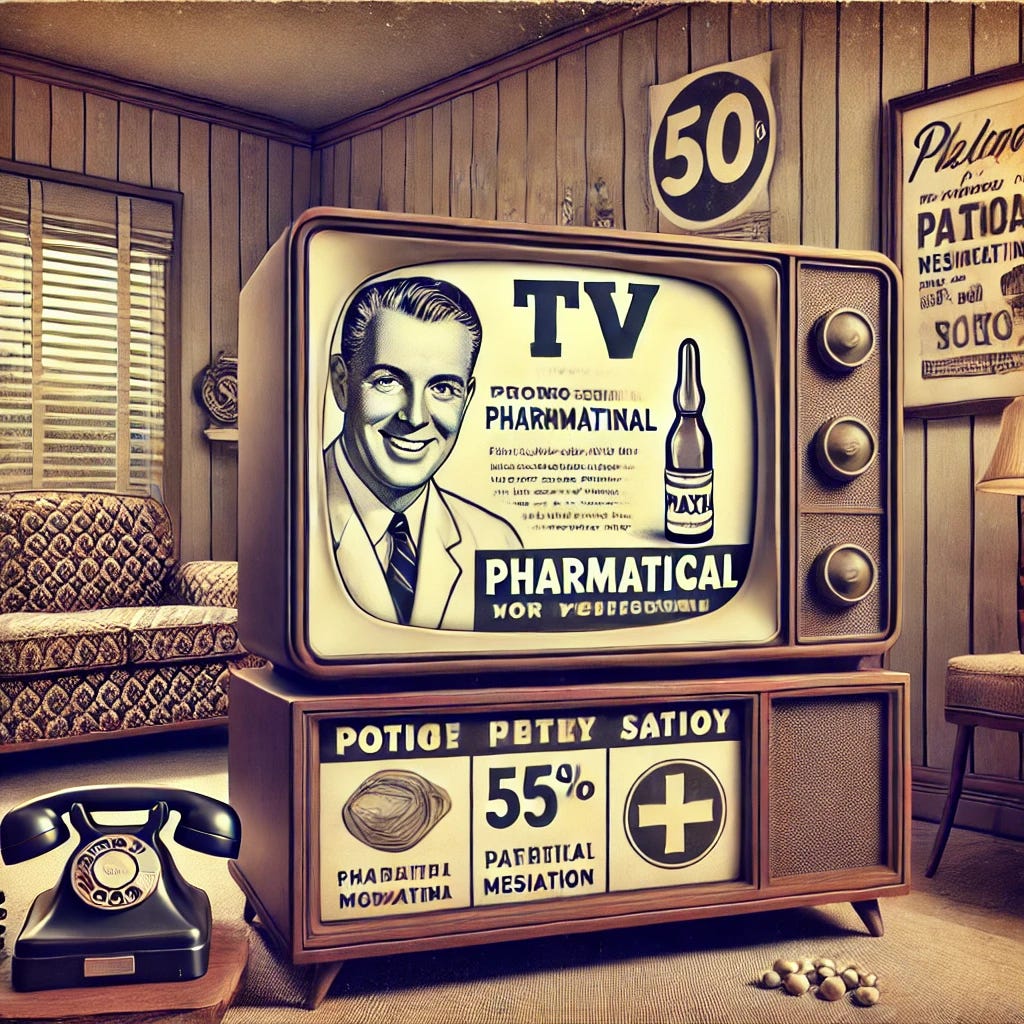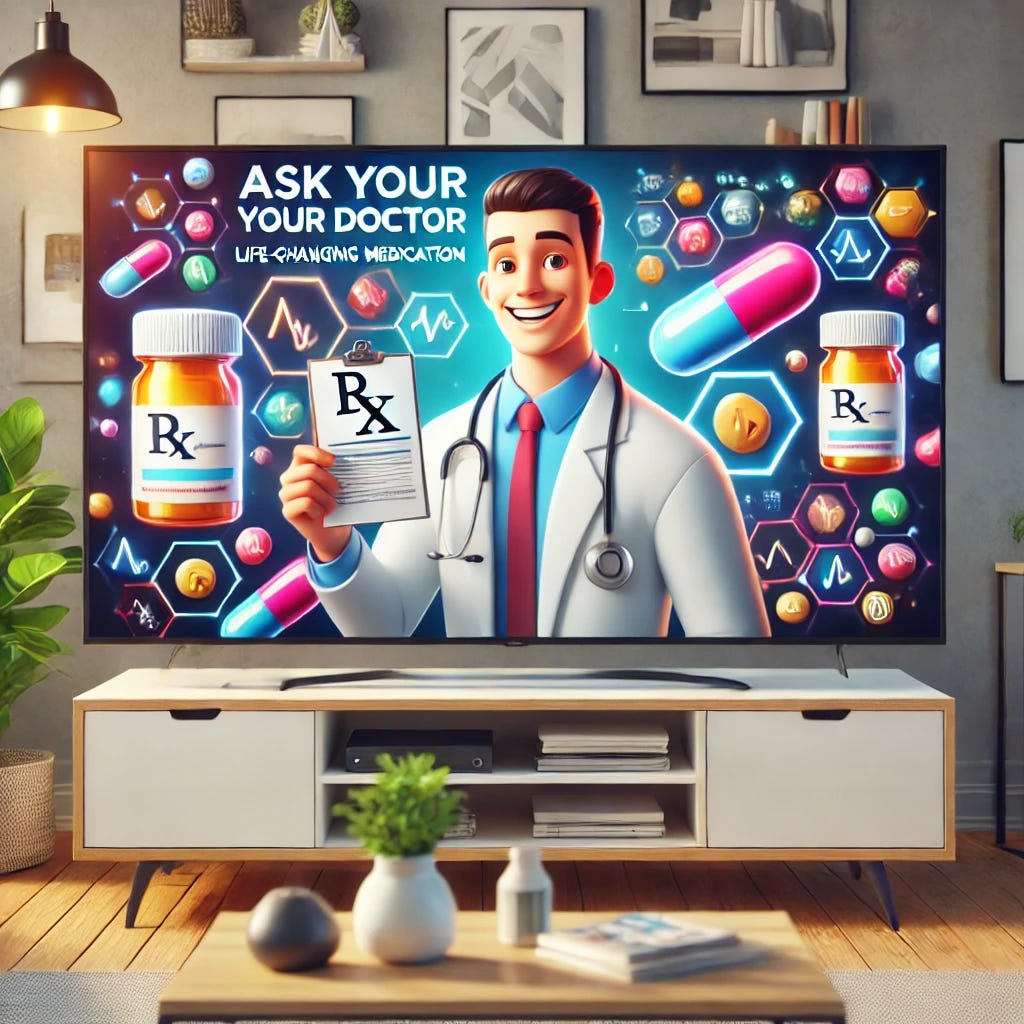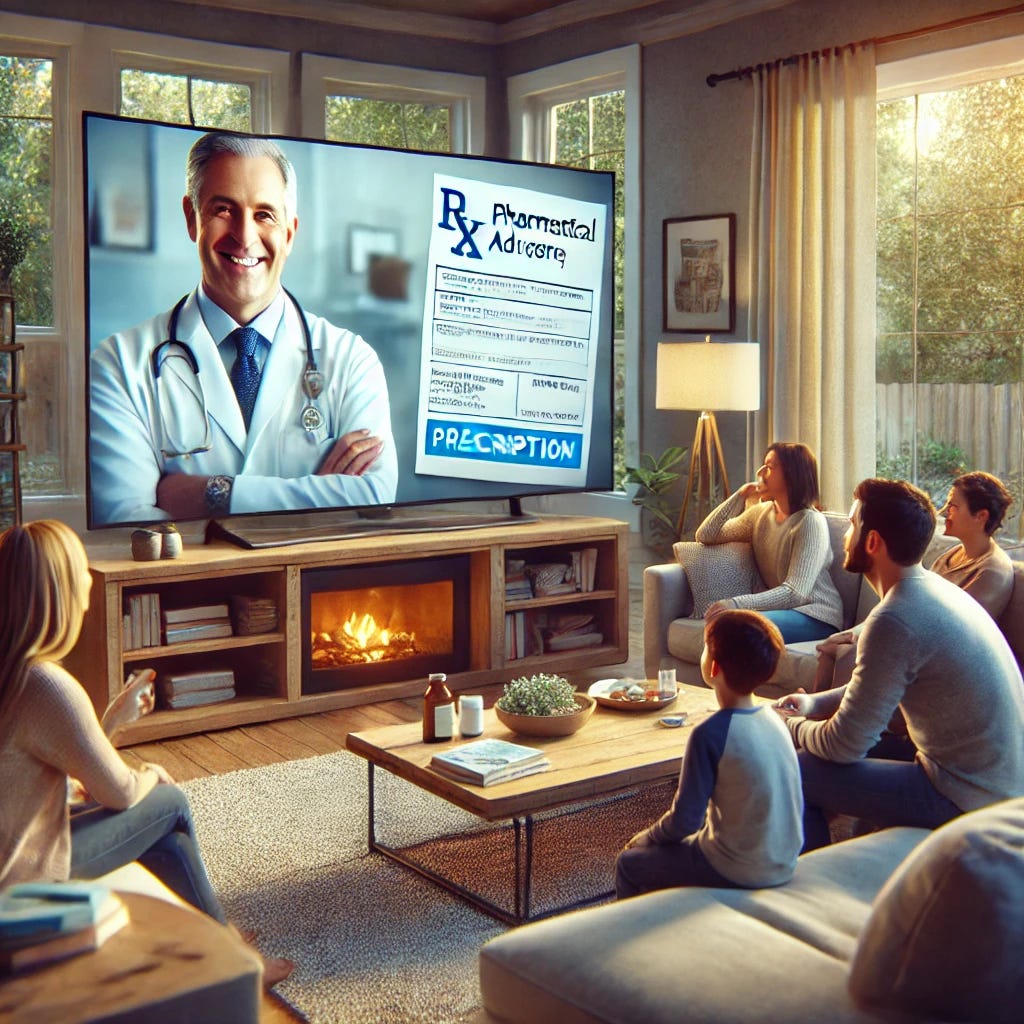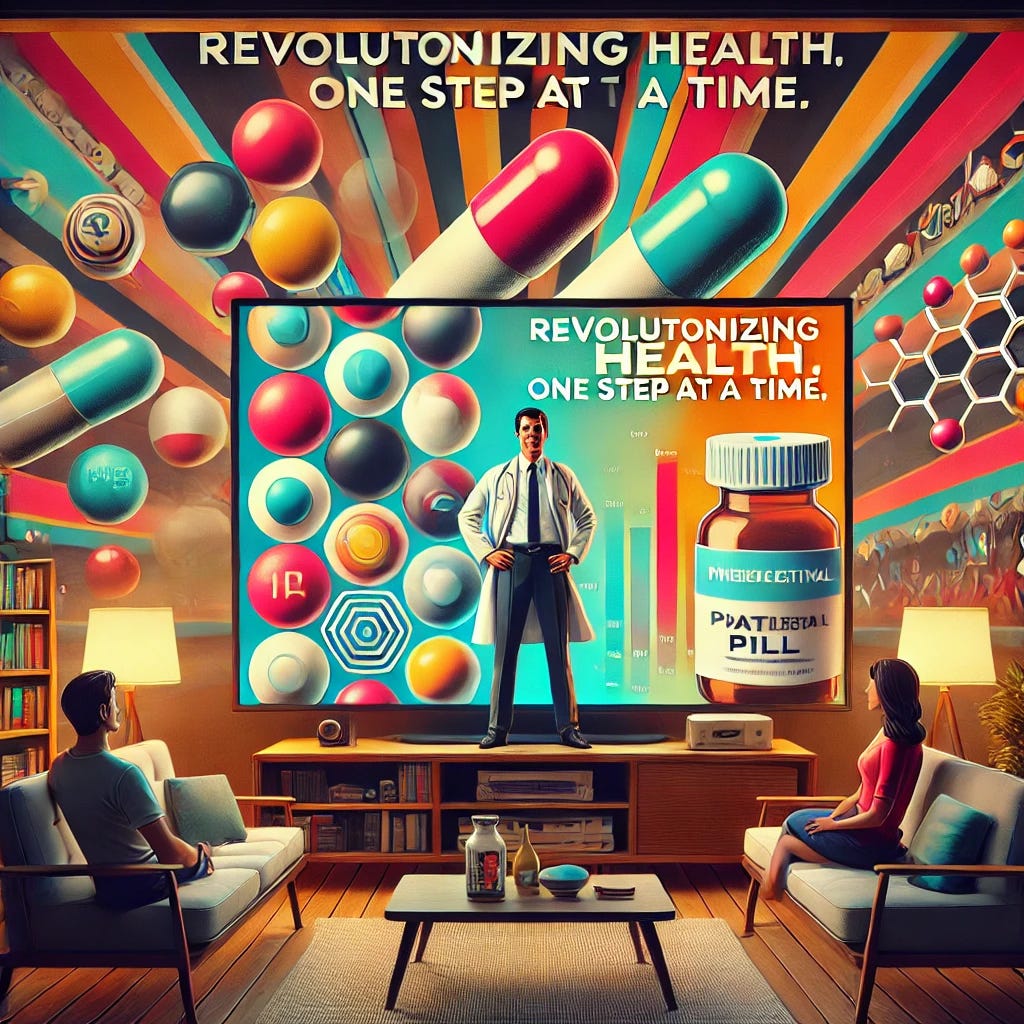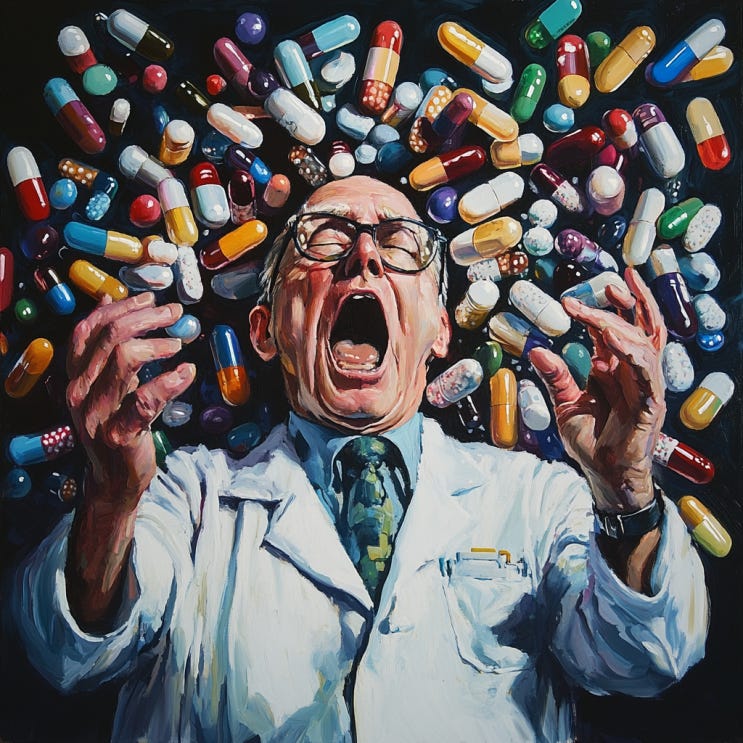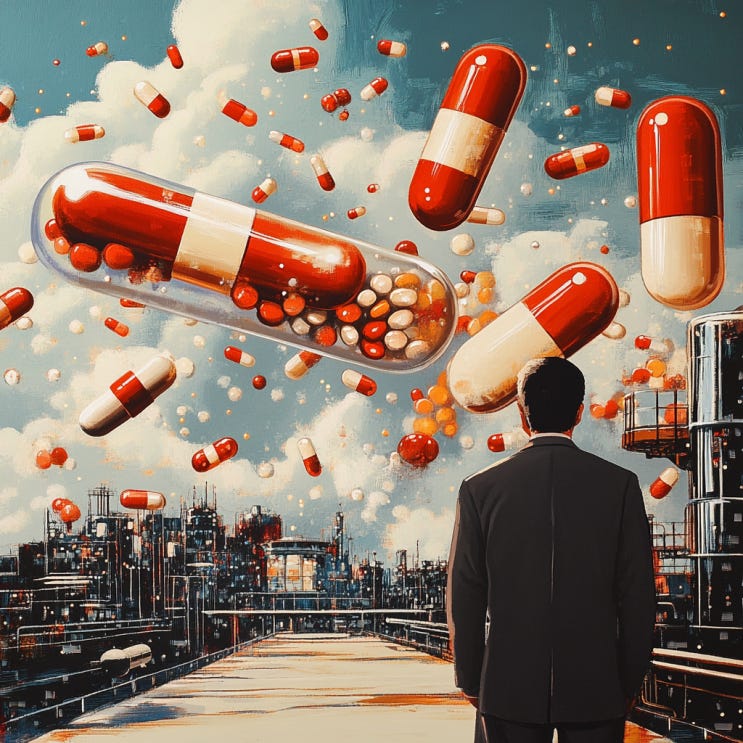In Defense of Pharma TV Ads in the U.S.
Big pharma TV commercials likely increase ROI to fuel innovation
This is far from a popular position, but I think it is the smart one.
Banning pharma/biotech ads on TV in the U.S. sounds good on the surface but is likely a dumb policy to actually implement.
My logic in defense of pharma TV ads is as follows:
Pharma ads generate higher ROI for “big pharma”: Every $1 spent on TV ads is thought to generate over $4 in profits for big pharma.
Higher ROI helps fund R&D & clinical trials: The ROI boost from TV ad spend marketing helps big pharma fund more R&D and future clinical trials.
Increased odds of better treatments/cures in future: More R&D and future clinical trials increases the odds of better treatments and/or cures.
Cycle sustainment: Higher ROI from meds -> increased R&D funding -> more pipeline developments & clinical trials -> increased odds of better future treatments and/or cures.
Other reasons I’m in favor of pharma TV ads:
Pharma/biotech is already heavily regulated (including the TV ads): The regulations in pharma/biotech are already excessive. Deregulation would be better.
Pharma/biotech “patents” & IP expire rapidly and/or are stolen: Pharma already has an uphill battle – why make it more difficult?
Economic benefits: From pharma companies buying ad slots. May drive up ad prices and earnings for TV programs/networks.
Historical efficacy: The U.S. continues to lead in pharma/biotech innovation and has permitted TV ads. If it ain’t broken (like EU, UK, Canada, etc.) why change it?
May lower drug costs: If more people are aware of a drug and seek it out as a result of a TV commercial, pharma companies may be able to lower their pricing due to increased total interest/sales.
Patient awareness (medical conditions & treatments): Pharma TV ads can raise awareness about certain medical conditions (potentially decreasing stigma) and simultaneously make people aware of medical conditions that they might have and/or treatments that some might not know existed.
Why Banning Pharma TV Ads is a Bad Idea: Extended Logic
The idea of banning pharmaceutical and biotech TV ads in the U.S. often seems appealing at first glance.
Critics argue that these ads inflate healthcare costs, encourage over-medication, and prioritize profits over public health.
However, banning such ads could have unintended and far-reaching negative consequences.
1. Pharma Ads Generate High ROI for Big Pharma
Significant Returns on Investment
Every $1 spent on TV ads generates an estimated $4.90 in revenue for pharmaceutical companies.
This return on investment (ROI) demonstrates the power of advertising in creating awareness and driving demand for medications.
Connected TV Outperforms Traditional Media
Connected TV (CTV) campaigns amplify these returns by offering 30% higher ROI compared to traditional channels, largely due to precise audience targeting.
These platforms help pharmaceutical companies reach patients who might benefit most from their products, ensuring a focused and effective advertising spend.
Case Study: Diabetes and Weight Loss Medications
Novo Nordisk, the maker of Ozempic, allocated $208 million for TV ads in 2023, which contributed to a 36% increase in global sales.
The campaign not only drove revenue but also broadened awareness about diabetes management and obesity treatments, underscoring the link between effective advertising and business success.
2. Higher ROI Funds R&D and Clinical Trials
Revenue as a Catalyst for Innovation
The high ROI from TV advertising directly supports research and development (R&D).
With pharmaceutical companies reinvesting a significant portion of their profits into developing new drugs, the ad-driven revenue stream becomes a lifeline for innovation.
Investment in Trials
Developing a single drug costs an average of $1-2 billion and can take over a decade.
Advertising revenue helps fund clinical trials that determine the safety and efficacy of new treatments, ensuring that breakthroughs continue to emerge.
Real-World Example
AbbVie, a company known for its heavy advertising of Skyrizi and Rinvoq, uses profits to invest in clinical trials for autoimmune diseases.
In Q3 2024 alone, AbbVie spent $93.7 million on Skyrizi ads and $76.1 million on Rinvoq ads.
These ads likely generated higher ROI for AbbVie’s drugs: Skyrizi generated over $2B in Q1 2024 (47% YoY increase) and Rinvoq achieved $1.09B in global sales (59% growth).
AbbVie has been able to increase annual R&D investment from ~$2.8B in 2013 to ~$5.8B in 2020 likely as a result of commercial drug success bolstered by pharma TV ads.
3. Increased Odds of Better Treatments and Cures
Expanding the Pipeline
More funding for R&D leads to a higher number of clinical trials, which increases the likelihood of discovering life-changing treatments.
The cycle of reinvesting advertising profits into innovation ensures a steady flow of new therapies entering the market.
Case Studies in Innovation
Groundbreaking treatments, such as immunotherapies and advanced cancer drugs, are often the result of sustained R&D investments.
These innovations benefit from the financial stability provided by advertising revenue.
Impact on Rare Diseases
Pharmaceutical advertising indirectly supports the development of treatments for rare diseases, where smaller patient populations might otherwise make investment less viable.
By offsetting costs through profitable drugs advertised to larger audiences, companies can take on riskier projects.
4. Sustaining the Innovation Cycle
Pharma TV ads are an essential component of a virtuous cycle:
Higher ROI from advertising creates more revenue.
Increased revenue funds additional R&D.
More R&D leads to better treatments and cures.
Improved treatments generate further revenue, sustaining the cycle.
This model ensures that advancements in medicine continue without compromising the financial health of companies investing in innovation.
Other Reasons to Support Pharma TV Ads
1. Pharma/Biotech is Already Heavily Regulated
Pharmaceutical ads are among the most tightly regulated forms of advertising:
The FDA requires ads to include detailed disclosures about risks, side effects, and limitations.
In 2024, regulations were further tightened to simplify language and ban distracting visuals, improving consumer understanding.
Ads undergo voluntary pre-approval by the FDA in most cases, ensuring compliance before airing.
2. Patents and Intellectual Property Challenges
Pharmaceutical companies face rapid patent expirations, often losing exclusivity within 20 years.
Additionally, intellectual property theft in international markets poses a significant challenge.
Advertising revenue provides a crucial buffer, helping companies recoup development costs before generics flood the market.
3. Economic Benefits
Pharmaceutical companies are among the largest buyers of TV ad slots:
In Q3 2024, pharma companies spent $4 billion on TV advertising, supporting media outlets and creating jobs.
The ripple effect extends to industries like marketing, production, and broadcasting, bolstering the economy.
4. Historical Efficacy
The U.S. leads the world in pharmaceutical and biotech innovation, a success story partly attributed to its permissive approach to advertising.
Countries like Canada, the UK, and the EU, which ban direct-to-consumer (DTC) ads, lag behind in developing breakthrough treatments.
5. Potential to Lower Drug Costs
Contrary to critics’ claims, increased demand from advertising could create economies of scale, allowing pharmaceutical companies to lower prices per unit while maintaining profitability.
Higher sales volumes can offset fixed costs, potentially reducing patient expenses.
6. Raising Awareness of Medical Conditions & Treatments
Pharmaceutical ads play a critical role in educating the public:
Reducing Stigma: Ads for mental health treatments and conditions like erectile dysfunction normalize discussions and encourage patients to seek help.
Highlighting Undiagnosed Conditions: Many people learn about their symptoms and potential treatments through ads, prompting life-saving doctor visits.
Examples: Ads for Viagra and Cialis not only drove sales but also started conversations about men’s health, leading to increased diagnosis and treatment rates.
The Costs of a Ban on Pharma TV ads
Pharmaceutical TV ads are far from perfect, but their benefits far outweigh the drawbacks. They provide critical funding for R&D, raise awareness of underdiagnosed conditions, and drive economic growth.
Instead of banning these ads, regulators should focus on improving transparency and ensuring that they empower consumers without misleading them.
Reduced Awareness: Without ads, patients might remain unaware of available treatments, leading to underdiagnosis and untreated conditions. This is especially true for newer therapies or stigmatized conditions.
Economic Impact: A ban could hurt the advertising ecosystem, resulting in lost revenue for media companies, fewer jobs, and reduced funding for content creation. This disruption could have widespread implications for the economy.
Innovation Slowdown: Eliminating a major revenue source could force pharmaceutical companies to cut back on R&D, slowing the development of new treatments and cures.
By maintaining a balanced approach, the U.S. can continue to lead in pharmaceutical innovation while supporting patients and the broader healthcare ecosystem.
Banning pharma TV ads in the U.S.: Potential impact on pharma innovation…
The total impact of banning pharmaceutical TV ads on innovation would likely be moderate but not catastrophic.
While the impact may not cripple pharmaceutical innovation entirely, a ban on TV ads would introduce measurable delays and reductions in R&D output, particularly for high-risk, high-reward areas of medicine.
Policymakers should carefully weigh these trade-offs before implementing such a policy and consider alternative regulations that preserve funding while addressing public concerns about advertising practices.
1. Revenue Reduction and R&D Cuts
Revenue Loss: A ban could reduce pharmaceutical industry revenue by an estimated $19.6 billion annually or more, removing a critical source of funding for research and development (R&D).
Direct R&D Impact: With 15-20% of revenue typically allocated to R&D, this would translate to $3-4 billion in reduced annual R&D spending, affecting high-risk, high-reward areas like rare disease treatments and gene therapies.
2. Fewer Clinical Trials
Reduced Pipeline Activity: The funding loss could lead to 15-20 fewer new drug candidates entering clinical trials annually, delaying or halting progress on innovative treatments.
Niche Therapies at Risk: High-cost therapies for small populations, such as orphan drugs, would face disproportionate funding challenges.
3. Slower Adoption of Novel Therapies
Public Awareness Decline: Without TV ads, fewer patients would learn about new treatments, slowing adoption and sales. This could reduce funding available for reinvestment in R&D.
Delayed Medical Breakthroughs: Reduced awareness could slow the market penetration of transformative therapies like immunotherapies or advanced diabetes treatments.
4. Impacts on Smaller Biotech Firms
Loss of Partnerships: Smaller biotech companies often rely on partnerships with larger pharmaceutical firms to bring treatments to market. A funding reduction may make larger firms less willing to take on high-risk projects from smaller players.
Consolidation Risks: Reduced revenues could lead to fewer acquisitions of innovative biotech startups, slowing the pace of technological integration into mainstream medicine.
5. Economic Ripple Effects
Supply Chain Impacts: Reduced innovation may slow demand for specialized manufacturing, clinical trial services, and advanced drug delivery technologies, affecting adjacent industries.
Loss of Advertising Jobs: A ban would remove a major revenue source for media companies, potentially leading to job losses and reduced funding for public health campaigns.
6. Global Competitive Position
Reduced U.S. Leadership: The U.S. leads the world in pharmaceutical innovation partly because of its permissive stance on advertising. A ban could diminish its competitive edge, allowing countries with emerging pharmaceutical sectors to catch up.
Innovation Shifts Abroad: Companies may redirect resources to markets with lower regulatory barriers, slowing innovation in the U.S.
Free market capitalism is optimal – increased regulation may harm pharma/biotech…
Free market capitalism is essential for fostering innovation in the pharmaceutical and biotech industries.
Regulations like banning TV ads could unintentionally undermine the financial stability and innovation pipeline of these sectors.
1. Short Patent Windows Make TV Ads Critical
Limited Exclusivity: With 20-year patents, much of the window is consumed by R&D and FDA approvals, leaving companies with as little as 5-10 years to maximize profits before generics enter the market.
High Stakes for Revenue: TV ads help rapidly boost awareness and sales during this short period, ensuring companies recoup development costs. Removing this tool would make it harder for firms to recover investments and fund future innovations.
2. Intellectual Property (IP) Theft Compounds Financial Risks
Foreign IP Theft: Countries with weak enforcement of IP laws, like China, often replicate patented drugs, flooding global markets with cheaper alternatives.
Regulatory Double Hit: Preventing TV ads reduces domestic revenue streams, while IP theft diminishes international earnings. This one-two punch would leave companies with fewer resources for R&D.
3. Compounding Pharmacies and Pricing Pressure
Discounted Alternatives: Compounding pharmacies legally sell custom formulations of patented drugs at lower costs, cutting into the revenue of branded pharmaceuticals.
Role of TV Ads: Advertising helps branded drugs differentiate themselves and emphasize quality, safety, and FDA approval, giving them a competitive edge over compounded alternatives. A ban would strip this advantage, further eroding profits.
4. The Free Market Encourages Risk-Taking
Profit as Incentive: The free market motivates companies to invest in risky, expensive innovations by offering the potential for high returns. TV ads amplify this opportunity by reaching large audiences quickly and driving sales.
Regulatory Chill: Removing advertising as a revenue driver reduces the financial rewards of risk-taking, potentially shifting focus away from groundbreaking research toward safer, incremental innovations.
5. Impact on U.S. Leadership in Pharma
Global Innovation Leader: The U.S. leads in pharmaceutical breakthroughs, partly because of its permissive stance on direct-to-consumer (DTC) advertising, which drives revenue and competition.
Risk of Stagnation: Increased regulation, such as banning TV ads, could place the U.S. at a competitive disadvantage compared to countries with fewer restrictions on pharma marketing.
6. Disruption to the Pharma Ecosystem
Reduced Advertising Budgets: Pharma TV ads generate billions in revenue, which fuel clinical trials, R&D, and even early-stage biotech partnerships. Without this funding, the entire innovation pipeline could slow.
Broader Economic Impact: Media companies, marketing agencies, and adjacent industries benefit from pharma ad spending. Banning these ads would have ripple effects, reducing job creation and economic growth in related sectors.
But Pharma TV Ads are Banned in the EU, UK, Canada… So are Many Other Things
“But pharma TV ads are banned everywhere else outside the U.S.”
This is one of the dumbest arguments against pharma TV ads you could make – but has become a popular argument against them.
Many things are banned and/or have become forced regulations outside of the U.S. including: (1) bans on: GMOs, guns, facial recognition, free speech AND (2) forced: low emissions, digital cookies notices, paid vacation, etc.
The reason the U.S. is ahead of these countries in productivity and innovation is because it remains more aligned with free market capitalism (fewer regulations, less taxes, etc.).
And one small reason it remains ahead in pharma/biotech innovation is partly due to TV ads – which help generate higher ROI for pharma/biotech companies and help fund more R&D, clinical trials, and more subsequent novel treatments for diseases.
GMOs: The EU and UK have strict regulations on GMOs – resulting in bans or strict labeling requirements. Anyone who understands science realizes that the GMO ban is retarded. There is zero strong evidence to support the idea that GMOs are harmful… they are simply “genetically modified” to enhance survivability, nutrition, and taste.
Guns (firearms): Heavily regulated in the EU, Canada, and UK. Outright bans on many types of guns and accessories that are completely legal in the U.S. Most other countries do not allow handguns for self-defense, semi-auto rifles (e.g. AR-15s), high-capacity magazines, suppressors, concealed carry, private gun sales, etc.
Artificial smoke flavoring agents: The EU banned artificial smoke flavorings in smoky-bacon flavored crisps due to potential cancer risks. Whether these smoke flavorings actually cause cancer remains unclear.
Cookies notices (GDPR enforcement): Europe has strict GDPR rules for personal data collection. They basically made the internet more annoying by requiring “cookies” notices on every website. The U.S. doesn’t require this and companies can retain data indefinitely unless otherwise specified.
Facial recognition: EU and Canada heavily regulate or outright ban the use of facial recognition tech in public spaces due to privacy concerns. The U.S. uses facial recognition tech extensively – especially in airports and by law enforcement to efficiently identify criminals.
High car emissions: Europe has strict emissions standards (Euro 6) and promotes EVs aggressively. The U.S. has weaker emissions regulations and is more lenient with fuel efficiency standards.
Free speech: The EU, Canada, and UK regulate “hate speech” and “misinformation” stringently – stifling critical thinking. In recent years people have been arrested and faced jail time for simply posting opinions on social media (e.g. FB, Twitter/X, etc.).
Forced paid vacation: The EU mandates at least four weeks of paid vacation, and countries like the UK and Canada require similar benefits, limiting workplace flexibility and increasing labor costs. These regulations reduce productivity and business adaptability.
Mandated parental leave: Europe, Canada, and the UK require lengthy, government-mandated parental leave, often paid for months. While beneficial for families, these mandates burden employers and discourage hiring in small businesses. The U.S. leads by offering flexibility, enabling faster workforce reintegration and economic agility.
Capped interest rates: The EU and Canada impose strict caps on loan interest rates to protect consumers, often making credit inaccessible to riskier borrowers. This limits financial innovation and entrepreneurship. The U.S. fosters economic growth by allowing market-driven interest rates, promoting investment and broader access to capital.
High pharma prices: EU and Canada regulate drug pricing heavily, capping profits and delaying new treatments' market entry. While this keeps prices lower, it stifles innovation and access to cutting-edge therapies. The U.S. leads in pharma breakthroughs by offering a free market for pricing, incentivizing investment in R&D.
Capped work hours with OT: The EU caps weekly work hours at 48 and mandates overtime pay, reducing workplace flexibility. These rules limit high-effort productivity, especially in competitive industries. The U.S. excels by allowing exempt employees to work unlimited hours, encouraging entrepreneurship and innovation in sectors like tech and biotech.
But the U.S. has worse health outcomes than other countries…
This is mostly irrelevant to pharma ads on TV.
Pharmaceutical ads are not responsible for worse health outcomes in the U.S., including obesity.
These ads primarily aim to raise awareness about available treatments and encourage proactive healthcare, particularly for chronic conditions like diabetes and heart disease, often linked to obesity.
In fact, such ads may even help reduce obesity by prompting individuals to seek treatment earlier.
The real driver of poor health outcomes in the U.S. is obesity, which is largely caused by a combo of: low-cost hyperpalatable food, ubiquitous food availability, large portion sizes, and sedentary lifestyles.
Blaming pharmaceutical ads distracts from the root causes of these challenges and ignores their potential benefits in helping patients manage conditions and improve their overall quality of life.
But “big pharma” in the U.S. doesn’t actually cure diseases…
Yes, they actually do.
Most people who think “big pharma” is trying to get you hooked on their meds for life are drinking too much conspiracy juice.
Has “big pharma” ever been dishonest or engaged in unethical/shady behavior? Sure – but so have people in every industry.
Those who think “big pharma” all bad are similar in their thinking to people who see one dirty police officer in the news and assume “all cops are bad” (ACAB)… this is actually a thing among fringe woke leftists.
Cures by Big Pharma
1. Hepatitis C
· Gilead Sciences: Sovaldi, Harvoni, Epclusa
· Achieves cure rates >95% by eradicating the hepatitis C virus from the body.
2. Sickle Cell Disease and Beta Thalassemia
· Vertex Pharmaceuticals & CRISPR Therapeutics: Exa-cel (CRISPR therapy)
· Gene-editing technology cures inherited blood disorders by correcting the underlying genetic mutations.
3. Acute Promyelocytic Leukemia (APL)
· All-Trans Retinoic Acid (ATRA): APL treatment combined with arsenic trioxide has led to cure rates of >90% in some cases.
4. Certain Bacterial Infections (with antibiotics)
· Merck & Co., Pfizer, et al.: Antibiotics like penicillin, amoxicillin, and azithromycin can cure bacterial infections such as syphilis, strep throat, and bacterial pneumonia.
Preventative Vaccines (Disease Reduction)
1. Measles, Mumps, Rubella (MMR)
· Merck & Co.: MMR Vaccine
· Prevents these viral diseases with nearly universal efficacy in vaccinated individuals.
2. Polio
· Wyeth, now Pfizer: Oral Polio Vaccine (OPV)
· Led to the near-eradication of polio globally.
3. Smallpox
· Dried Smallpox Vaccine (historical): Eradicated smallpox globally by 1980.
4. Human Papillomavirus (HPV)
· Merck & Co.: Gardasil
· Prevents HPV-related cancers, including cervical cancer, by eliminating the virus in vaccinated individuals.
5. Hepatitis B
· Merck & Co.: Hepatitis B Vaccine (Recombivax HB)
· Prevents chronic hepatitis B infections, significantly reducing the risk of liver cancer.
6. COVID-19
· Pfizer/BioNTech: Comirnaty (mRNA Vaccine)
· Reduces the risk of severe disease and death, though not a cure, it can prevent infection in many cases.
7. Influenza
· Multiple companies: Seasonal Flu Vaccines
· Prevents serious flu cases and complications.
8. Tetanus, Diphtheria, Pertussis (Tdap)
· Sanofi & others: Tdap Vaccine
· Prevents these life-threatening bacterial infections.
Improving Quality of Life in Serious Medical Conditions
Pharmaceutical advancements have led to highly effective treatments for serious conditions, significantly improving patient outcomes.
Even though these aren’t “cures” – they significantly improve quality of life for people with the conditions they’re used to treat.
1. Antiretroviral Therapy (ART) for HIV/AIDS
Impact: Transformed HIV from a fatal disease to a manageable chronic condition, reducing mortality and improving quality of life.
Notable Medications: Truvada, Biktarvy (Gilead Sciences)
2. Direct-Acting Antivirals (DAAs) for Hepatitis C
Impact: Achieved cure rates exceeding 95%, effectively eradicating the virus in treated individuals.
Notable Medications: Sovaldi, Harvoni (Gilead Sciences)
3. GLP-1 Receptor Agonists for Obesity and Type 2 Diabetes
Impact: Facilitated significant weight loss and improved glycemic control, reducing risks of cardiovascular diseases and other obesity-related conditions.
Notable Medications: Wegovy, Ozempic (Novo Nordisk)
4. Immune Checkpoint Inhibitors for Cancer
Impact: Revolutionized cancer treatment by enabling the immune system to target tumors, leading to durable responses in various cancers.
Notable Medications: Keytruda (Merck & Co.), Opdivo (Bristol Myers Squibb)
5. Monoclonal Antibodies for Autoimmune Diseases
Impact: Provided targeted therapy for conditions like rheumatoid arthritis and Crohn's disease, significantly improving patient quality of life.
Notable Medications: Humira (AbbVie)
6. Tyrosine Kinase Inhibitors for Chronic Myeloid Leukemia (CML)
Impact: Transformed CML into a manageable condition with high survival rates.
Notable Medications: Gleevec (Novartis)
7. Disease-Modifying Therapies for Multiple Sclerosis (MS)
Impact: Reduced relapse rates and slowed disease progression, enhancing patient functionality.
Notable Medications: Ocrevus (Genentech), Tysabri (Biogen)
8. CFTR Modulators for Cystic Fibrosis
Impact: Addressed underlying genetic defects, improving lung function and extending life expectancy.
Notable Medications: Trikafta (Vertex Pharmaceuticals)
9. Anticoagulants for Atrial Fibrillation and Thromboembolism
Impact: Prevented stroke and systemic embolism, reducing morbidity and mortality.
Notable Medications: Eliquis (Bristol Myers Squibb), Xarelto (Johnson & Johnson)
10. Antipsychotics for Schizophrenia and Bipolar Disorder
Impact: Managed symptoms effectively, enabling patients to lead more stable lives.
Notable Medications: Abilify (Otsuka Pharmaceutical), Seroquel (AstraZeneca)
Why banning pharma TV ads might not be the end of the world…
While I don’t think pharma ads should be banned from TV, there are some potential benefits associated with banning them.
So if they end up banned - I guess we should focus on the benefits.
1. Less Pressure on Physicians
Doctors often face requests for medications driven by ads, even when those drugs may not be the most effective or appropriate.
Without TV ads, physicians could focus on evidence-based treatments, leading to fewer unnecessary prescriptions and better health outcomes.
2. Fewer Misguided Health Decisions
Pharma ads frequently present medications as "quick fixes" for issues like pre-diabetes or weight management.
With fewer ads, patients may shift toward lifestyle changes—such as diet and exercise—that address root causes rather than relying solely on medications.
3. Greater Efficiency in Pharma Spending
Pharmaceutical companies spend billions on TV ads ($4.6 billion in 2020), often with low short-term ROI. Without the need for expensive TV campaigns:
Funds could be redirected toward R&D for new drugs and therapies.
Marketing efforts targeting physicians, which tend to deliver better ROI, could be expanded.
Drug prices might decrease if marketing costs are reduced, although this would likely require broader systemic reforms.
4. Emphasis on Drug Quality & Innovation
Without the ability to rely on marketing to drive consumer demand, companies may redirect efforts and:
Focus on developing better, more effective drugs to stand out in the market.
Compete based on clinical efficacy, safety, and cost-effectiveness, rather than brand awareness.
Build trust through scientific advancements and improved healthcare outcomes, which could shift the public's perception of the industry.
5. Less Psychological Manipulation
Pharma ads rely heavily on emotional storytelling, fear, or hope to drive demand for medications.
Eliminating these ads could lead to more thoughtful healthcare decisions, ensuring that patients and doctors rely on clinical evidence rather than marketing tactics.
6. Lower Drug Costs for Consumers (Potentially?)
TV advertising costs are ultimately passed on to consumers.
Removing this expense could theoretically reduce drug prices.
However, systemic issues like pricing practices and insurance reimbursement policies would still need reform for significant savings to materialize.
7. Less Distrust Toward the Pharma Industry
Pharmaceutical companies face criticism for prioritizing marketing over patient care.
Eliminating TV ads might improve public perception, focusing attention on their role in creating life-saving treatments rather than profit-driven advertising.
8. Decreased Patient Confusion
TV ads often oversimplify medical conditions, risks, and benefits, leading to misunderstandings.
With fewer ads, patients may turn to their doctors for personalized advice, improving clarity and decision-making.
9. Sales May Not Drop Significantly
Studies show that TV ads provide only modest sales boosts, often failing to justify their high costs.
Doctors rely on clinical data and established prescribing habits, so removing ads may have minimal impact on the overall demand for effective drugs.
Do you think pharma ads should be banned from TV in the U.S.?
I think it is reasonable to consider that since pharma ads are banned in many other developed countries – it may be worth banning them in the U.S. – after-all, they must have good reasons.
But we must remember that the U.S. is carrying the entire world on its back in pharma innovation (subsidizing new treatments/cures) AND other countries also regulate many other things the U.S. doesn’t.
The reason I wrote this article is because I think we should question whether other countries are actually benefitting from their bans of pharma TV commercials AND whether the U.S. would reap benefits or end up counterintuitively harmed (e.g. decreased sales & future R&D revenue, etc.).
I generally tend to err on the side of the free market – and I don’t see much wrong with pharma advertising on TV.


